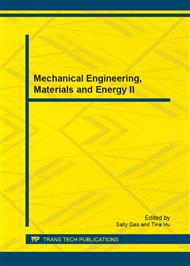p.245
p.250
p.254
p.258
p.263
p.268
p.272
p.276
p.282
Dynamic Modeling and Modal Analysis of the High-Speed Winder Spindle
Abstract:
A model of the spindle which is one of key parts of the high-speed winder is presented in this paper. A cantilever type hollow bobbin, a flexible shaft, bearings, Elastomer O-Rings and the frame is included in the model. Comparison between the 3D finite solid element model and the beam element model is made in the modal analysis. Critical speeds and the corresponding whirling motions are obtained from the beam finite element model considering the effect of rotatory inertia, gyroscopic moments, and the damping. The dynamic analysis mentioned above is implemented by using the finite element software ANSYS. Calculation results in this paper facilitate the following dynamic analysis and a foundation for the performance improvement of the high-speed winder.
Info:
Periodical:
Pages:
263-267
Citation:
Online since:
January 2013
Authors:
Price:
Сopyright:
© 2013 Trans Tech Publications Ltd. All Rights Reserved
Share:
Citation:


